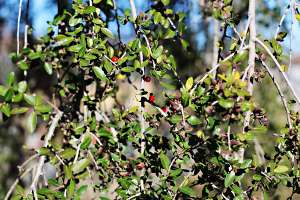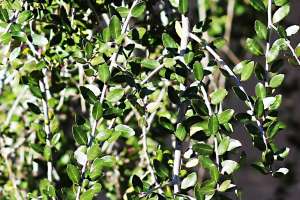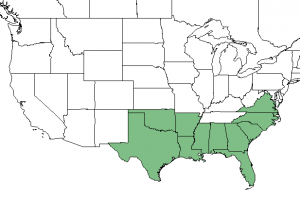- Identification
- Range & habitat
- The only native caffeine plant
- Ilex vomitoria
- How to harvest and process
- Yaupon tea recipe
Yaupon holly (Ilex vomitoria) is an evergreen tree or shrub that's native to coastal areas of the south/southeastern United States.
It's fairly easy to identify by its light, whitish-gray smooth trunk and stems, and by its small, shiny dark green leaves.
Both male and female plants make small white flowers in the spring. Female trees make toxic berries which remain on the shrub through fall and winter.
It's easier to identify yaupon hollies in the fall when they have berries, which can be red, orange, or yellow.

Yaupon holly with berries
The yaupon’s small dark green ovate to elliptical leaves are scalloped and occur alternately on the stem.
Trees may grow as tall as 25 or 30 feet.

Range & Habitat

Yaupon holly occurs naturally from Texas east to Florida and north to the southern part of Virginia.
Its favorite habitat comprises maritime forests, salt marshes, and the woods and swamps of the coastal plain at elevations below 500 feet.
But due to yaupon's popularity historically as a Native American cultivated crop and currently as a hardy landscaping plant, yaupon can occur at higher elevations as far inland as the North Carolina mountains.
U.S. native caffeine source
Yaupon holly is the only plant (that we know of) native to the United States that contains caffeine.
It's a close cousin of the South American yerba maté (Ilex paraguariensis), and tea made from parched yaupon leaves tastes similar to yerba maté and the caffeine content is similar.
Tea made from fresh yaupon leaves is more like green tea.
Ilex Vomitoria misnomer
Yaupon holly is associated with a few names; the black drink, the white drink, cassine, cassina, and of course its Latin name, Ilex vomitoria.
Ilex vomitoria is the name that seems to stick in everyone's craw.
For ages, the conventional theory has been that Ilex vomitoria was named for its purported emetic properties which were witnessed in Native American ceremonies wherein Indians would drink the black drink and then purge or vomit.
But contrary to its name, Ilex vomitoria is not emetic, at least the tea isn't, and there are numerous historical writings that reference the casual consumption of yaupon tea, or cassine, without mention of vomit.
In Bartram 's Travels, William Bartram wrote, "The king conversed, drank Cassine and associated familiarly with his people and with us."
And in another passage, he wrote of meeting with Indian chiefs and warriors as they "...spent the evening and greater part of the night together, in drinking Cassine and smoking Tobacco."
According to anthropologist and ethnologist William C. Sturtevant, the Spaniards who founded St. Augustine, Florida, learned to drink yaupon tea from the Timucua Indians and they became addicted in the same way lots of us are addicted to coffee.
In Black Drink: A Native American Tea, Sturtevant wrote, "In 1615 Father Francísco Ximénez...reported that it was drunk first thing in the morning and that 'there is no Spaniard or Indian who does not drink it every day in the morning and evening . . . it is more of a vice than chocolate in New Spain.'"
As far as I know, there's no real explanation at this point for why yaupon got stuck with such an off-putting name when it was clearly as much of a daily routine as black tea or coffee is now.
Unfortunately, though, yaupon's marketability seems to have been negatively affected by the vomit stigma. In a time when local, organic food is in such high demand, a product like yaupon should also be in high demand.
A 2014 University of Florida study indicates that the vomitoria misnomer could be to blame for yaupon's lack of popularity.
From a summary of the research:
In a "blind" taste test conducted by Wainwright as part of her senior thesis research, yaupon was preferred over yerba mate even by frequent drinkers of the latter. One reason for the disregard of yaupon was revealed by her study. Although yaupon and yerba mate are equally high in caffeine and anti-oxidants, the scientific name of yaupon (Ilex vomitoria) caused participants to be leery of buying it, even though research indicates that yaupon is no more emetic than Ceylon tea, coffee, or cola drinks.
Several companies are now selling yaupon tea commercially, so it could catch on again if we can get past the vomit association.
Harvesting and processing
You can use fresh, dried, or roasted leaves and/or stems to make yaupon tea, but avoid the poisonous berries.
It’s really easy to harvest the leaves by grabbing the stem near the trunk and sliding your hand outward stripping them off. Or you can just cut the entire stem which makes air-drying easier.
To air-dry yaupon leaves on the stem, hang the stems in a warm, dry area for a couple of weeks. Make sure you put something like a sheet pan underneath to catch the leaves that will inevitably fall from the stem.
To expedite the drying process, spread the fresh leaves out on a sheet pan or a dehydrator tray, making sure not to pile them on top of each other and to give them plenty of breathing room -- they should be spread out in a single layer.
Then dehydrate in an oven or dehydrator set at 200 degrees F for a few hours.
You can also roast the leaves in the oven or parch on a stove top at 350-400 degrees F. Native Americans traditionally parched them to a dark brown over a fire.
Parching or roasting, even in an oven without smoke, gives the leaves a smoky flavor similar to yerba maté (Ilex paraguariensis).
Once the leaves are dried and/or parched, crumble them with your fingers or with a mortar and pestle and store in airtight glass jars just like you would store any herbal tea.
Yaupon Tea Recipe
Ingredients
- 1 to 1.5 teaspoons yaupon leaves, fresh, dried, parched or roasted (or 1 tea bag)
- 1 cup water
Instructions
- Boil water and pour into a cup with loose yaupon leaves, tea ball, or tea bag
- Let steep for five to ten minutes and remove the tea ball or strain out the leaves.
Notes
Use fresh or dried yaupon leaves for a tea that tastes more like green tea, or use parched or roasted leaves for a smokier tea that tastes more like yerba maté.